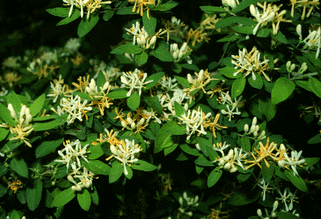
There are those folks out there that use honeysuckle almost exclusively for their Basket weaving material. The Cherokee's still use a lot of native and Japanese honeysuckle in their work in random weave, twining, twill and rib basketry. Most of what I've used it for over the years tends to be as an additional sculptural element. The reason why is that the make up of the vine lends itself to being celebrated as a special feature, not just a normal weaver.
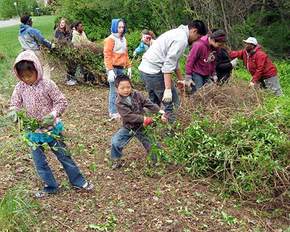
As a young vine, the honeysuckle vine runners can be very, very long - 20ft or more - and very pliable. The vine has a fine, paper-like bark on it that is a caramel brown color once it's matured a bit. When very young, it will be green. As the vine matures over years, it usually becomes crooked, very woody and has a lot of twists and turns. Usually you'll find honeysuckle growing in wet, bottom areas like around creeks, marshes or rivers. You can also find honeysuckle growing on barns, buildings or in gardens. There are lots of different varieties that can be cultivated for home enjoyment within your own basketry garden.
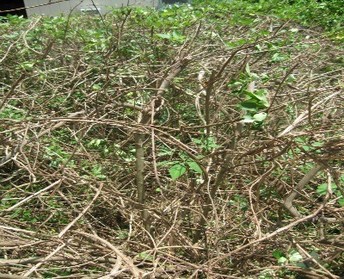
"Identification: Japanese Honeysuckle is an evergreen woody vine that may reach 80 feet in length. The leaves are opposite and elliptically shaped. The tan vine may reach a thickness of 2 inches in diameter. Fragrant, white or pale yellow tubular flowers appear in April to August. Spherical, black glossy berries containing 2 to 3 seeds mature from June to March.
Ecology: Japanese Honeysuckle is a common invasive plant in the Southeast. The shade tolerant vine occurs along field edges, right-of-ways, under dense canopies, and high in canopies. This invasive vine colonizes by prolific vine growth and seeds that are spread by birds"
Ecology: Japanese Honeysuckle is a common invasive plant in the Southeast. The shade tolerant vine occurs along field edges, right-of-ways, under dense canopies, and high in canopies. This invasive vine colonizes by prolific vine growth and seeds that are spread by birds"
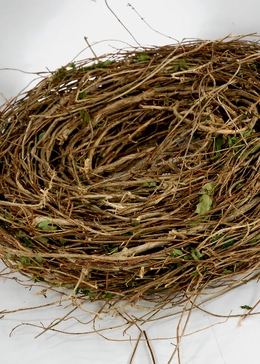
Like all vines, I recommend harvesting honeysuckle vine in the fall and winter months. That way they are less likely to snap when pulling them. You can always remember when pulling vines "Sappy Snappy". That basically means that when the sap is high, in the spring and summer months, vines are more likely to break when being harvested. Also, winter is a lot easier to harvest vines because there are very few bugs, no critters are out and all the leaves are gone.
Once you get your vines, you can store them in a cool, dry place until you're ready to use them. Just like the image here from one of my recent basket weaving classes, I recommend that you coil the vines into loose coils. However, be sure that they are small enough to fit in whatever pot you're going to use to boil them when you're ready to weave. Which brings me to the next step.
Once you get your vines, you can store them in a cool, dry place until you're ready to use them. Just like the image here from one of my recent basket weaving classes, I recommend that you coil the vines into loose coils. However, be sure that they are small enough to fit in whatever pot you're going to use to boil them when you're ready to weave. Which brings me to the next step.
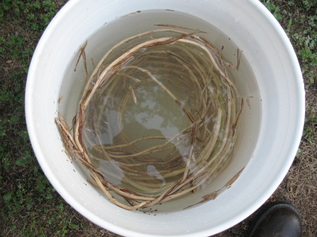
Whenever you're using honeysuckle vine, you'll want to boil it for 3 reasons, pliability, bugs and bark. Obviously, boiling makes the vines much more pliable and easy to use when weaving. Also, any bugs that are on the vines or in them for that matter will be nixed when you boil the vines. Lastly, boiling the vines will loosen up the bark so you can remove it from the vines. You'll want to boil honeysuckle vines for about 20-30 minutes or so - until they are rubbery flexible. (NOTE: Honeysuckle has a real papery outer bark that comes off pretty easily. It also has another layer of bark that's usually pretty tightly attached to the vine. Get that completely off too. It can be a pain, but once you get a clean vine, it will turn a beautiful ivory white.) With small vines, you can literally put on some 'gripper gloves' (you know the garden gloves with gripper on the palms and fingers), pinch the vine and pull the bark right off. With larger vines, I recommend you go all the way down the vine twisting the wet bark on the vine. Then once it's totally loosened up peel it off. If you're a papermaker, this bark is fabulous for natural fiber paper making. You can also use the long strands of honeysuckle bark for twining or making cordage.
Now that you have your honeysuckle all boiled and cleaned you'll probably be ready for a nap! Welcome to weaving with natural materials :) However, now the fun begins. I usually separate my prepared materials by size. Large, gnarly pieces are great for handles, long straight pieces for weaving and then medium crooked pieces for weaving or as an architectural element on other baskets. Whatever it is, you'll want to weave while the vines are wet and pliable.
Now that you have your honeysuckle all boiled and cleaned you'll probably be ready for a nap! Welcome to weaving with natural materials :) However, now the fun begins. I usually separate my prepared materials by size. Large, gnarly pieces are great for handles, long straight pieces for weaving and then medium crooked pieces for weaving or as an architectural element on other baskets. Whatever it is, you'll want to weave while the vines are wet and pliable.
 RSS Feed
RSS Feed
